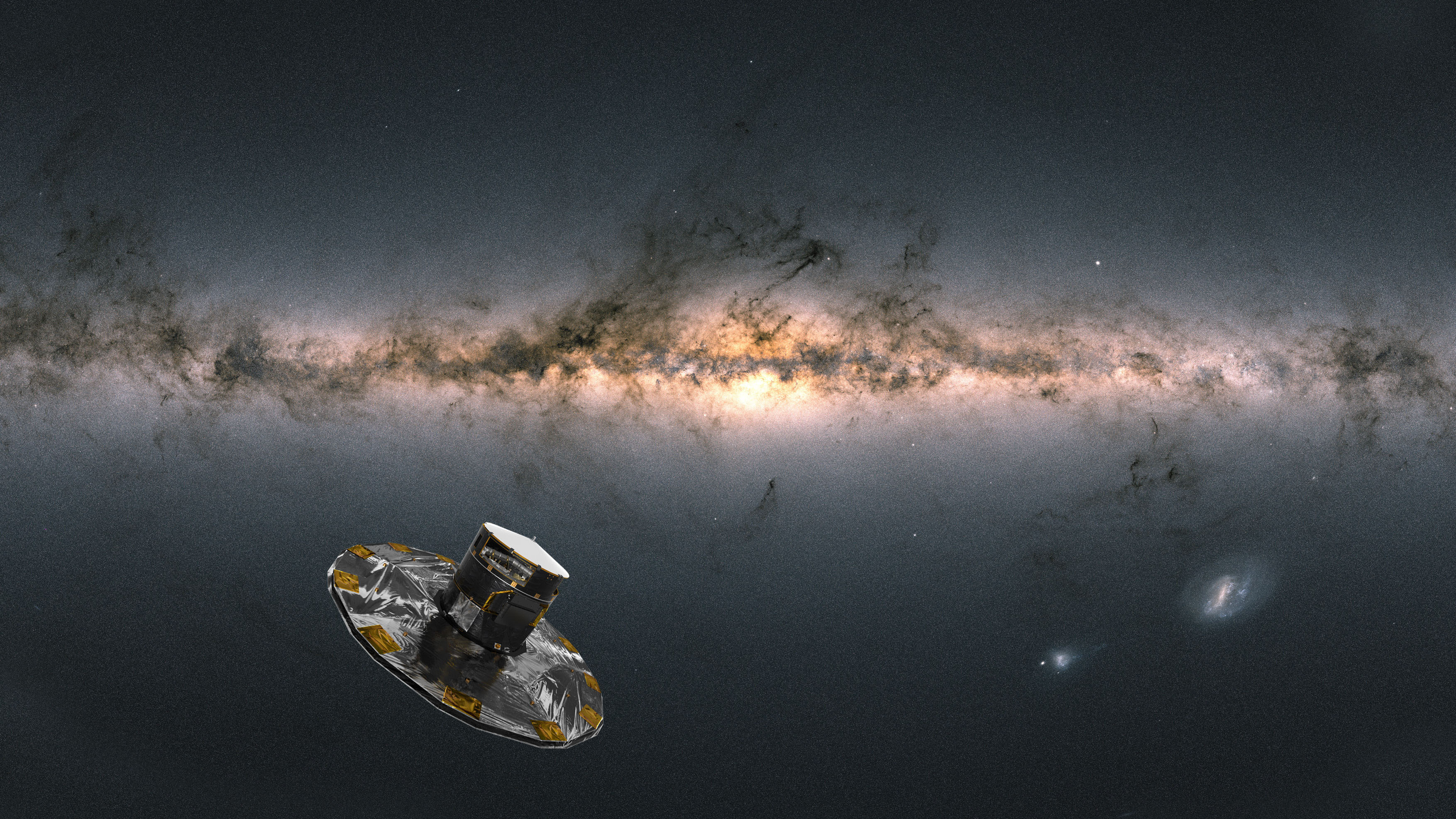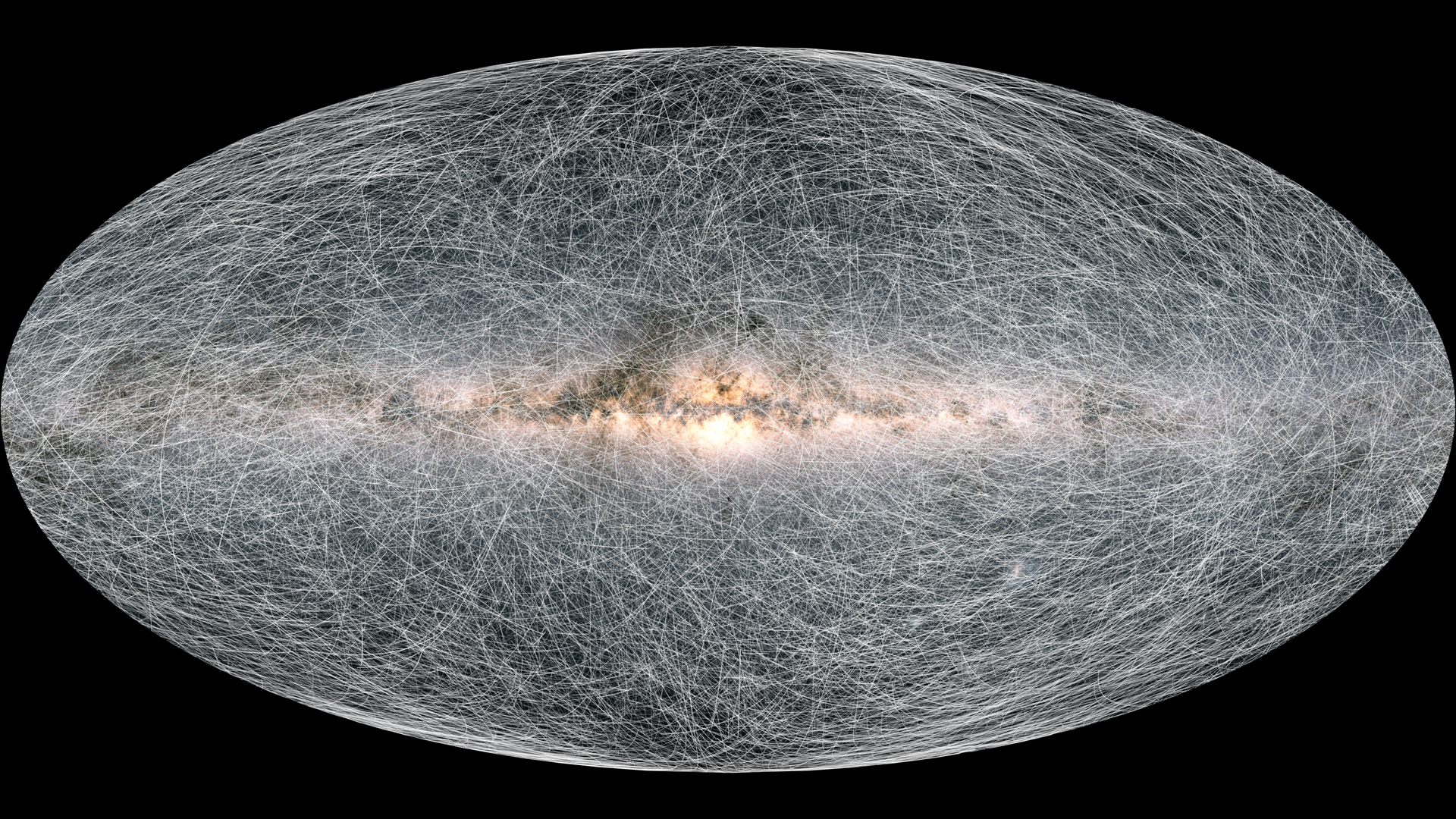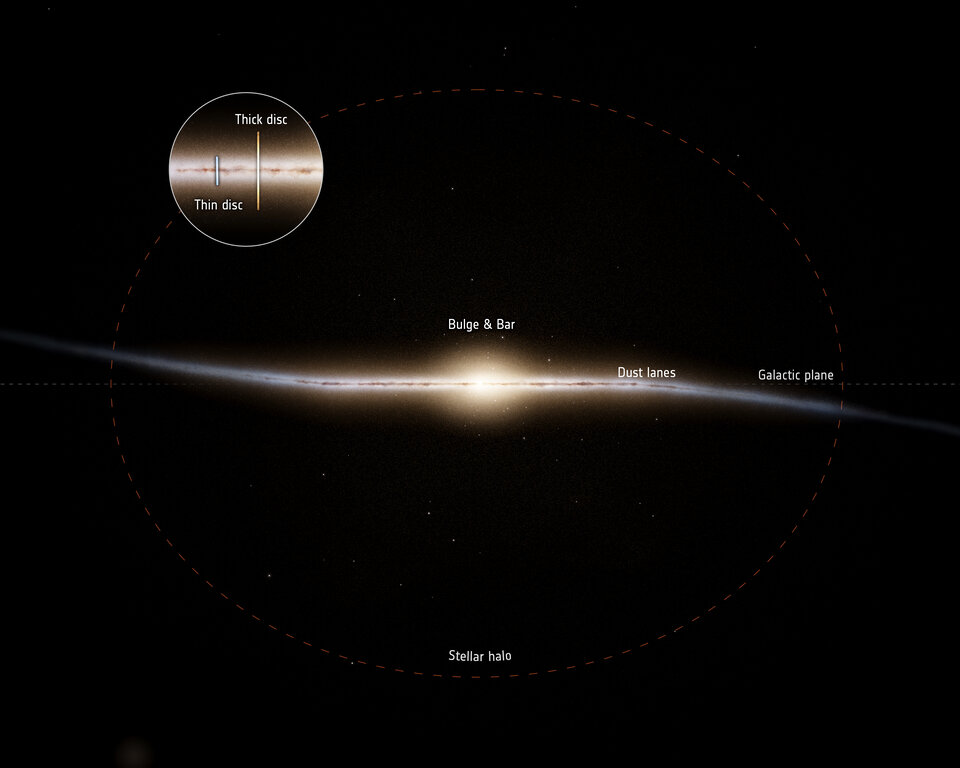New trove of Gaia data will uncloak the Milky Way's dark past and future
"You can reconstruct where groups of stars came from and which building block brought them into the Milky Way."

A space telescope that observes stars in the Milky Way as they appear today reveals what happened to the galaxy when it was just a couple of billion years old, and an upcoming data release will allow astronomers to peek into an even more distant past.
The European Space Agency's Gaia mission is not a household name like the Hubble Space Telescope or the James Webb Space Telescope. Yet the mission currently produces the most scientific papers and, as Milky Way researchers would tell you, has enabled unprecedented leaps in our understanding of the galaxy's history.
Gaia works differently than Webb or Hubble. Instead of observing the universe one fascinating distant object at a time, Gaia scans the whole sky over and over again. The flying-saucer-like telescope, nestled in Lagrange Point 2 some 930,000 miles (1.5 million kilometers) from Earth, observes 2 billion of the brightest stars in the sky, its view free from the distorting effects of Earth's atmosphere that plague ground-based telescopes' observations.
Related: 4 big Milky Way mysteries the next Gaia mission data dump may solve
Unlike Hubble and Webb, Gaia doesn't focus on capturing awe-inspiring images that reveal every detail of those distant stars and galaxies. Instead, the probe concentrates on a few basic parameters: the stars' distance from Earth, the speed at which the stars move through space, and the direction of their motion as it appears on the plane of the sky and in three dimensions.
Because objects in space follow the laws of physics, scientists can model the trajectories of those stars billions of years into the past and future, unpicking the events that shaped the galaxy's evolution. A discipline known as galactic archaeology has grown immensely since Gaia's launch in 2013, and the new data release coming Monday (June 13) is set to supercharge the research.
"We are still trying to unravel the details of the Milky Way's origins," Anthony Brown, an astronomer at Leiden University in the Netherlands and chair of the Gaia Data Processing and Analysis Consortium, told Space.com. "With the new release, we should be able to do it even better, because we are getting some new data."
Breaking space news, the latest updates on rocket launches, skywatching events and more!

Getting to know the stars
Those new data contain what astronomers call astrophysical parameters. Derived from the light spectra of the observed stars (essentially the fingerprints of how stars absorb light), the astrophysical parameters reveal ages, masses, brightness levels and, in some cases, detailed chemical compositions of the observed stars.
"You really get to know the stars," Jos de Bruijne, Gaia project scientist at ESA, told Space.com. "It's like you have an anonymous group of people and now you get to meet every one of them. You get to know their names and how old they are and where they came from."
The group of stars that astronomers "get to meet" thanks to the June 13 data release consists of half a billion individual objects, one-quarter of the stars Gaia observes. This information will help astronomers refine the order of events that shaped the Milky Way and "really untangle its formation history," Brown added.

What we already know
Astronomers think the Milky Way started forming only about 800 million years after the Big Bang and went through a 1 billion to 2 billion-year period of intense formation, Brown said. This formation period involved many collisions with other galaxies, which gradually built up the Milky Way into what we see today: a massive spiral galaxy encompassing 200 billion stars. (Gaia sees only about 1% of them.)
In the previously released Gaia data, researchers found imprints of those early collisions in the form of waves that still ripple through the galaxy, affecting the motion of stars. The most significant of these collisions was with a galaxy called Gaia Enceladus. That galaxy was about four times smaller than the Milky Way when the two crashed about 10 billion years ago. The collision, Gaia data revealed, gave rise to the Milky Way's halo, the sphere of thinly dispersed stars enveloping the galaxy's much more massive disk.
"At the moment, we think that [the collision with Gaia Enceladus] was the last significant merger that the Milky Way underwent," Brown said.

Tracing the "smallest building blocks"
Among the astronomers awaiting the June 13 data release is Eduardo Balbinot, a postdoctoral researcher in astrophysics at the University of Groningen in the Netherlands. Balbinot is interested in more modest collisions with what he calls the "smallest building blocks" of the galaxy: globular clusters, ancient groupings of stars devoured by the Milky Way over the eons.
"[The globular clusters] are special, because when they dissolve in these accretion events, they're torn apart," Balbinot said. "But they continue living as coherent groups of stars in the sky as what we call stellar streams."
These stellar streams have been notoriously hard to detect, but Balbinot thinks the new Gaia data will usher in a breakthrough in this endeavor.
"There will be an additional velocity component [in the new data set], the so-called radial velocity — how fast the stars move towards or away from us," Balbinot said. "Gaia measured some of those before, but the new sample will be 10 times bigger. It's bigger than anything before."
In those motions of stars, astronomers will be able to distinguish groups of stars that move through the galaxy in sync. By combining this information with data about the chemical compositions of stars (stars that arrived from other galaxies have distinct chemical profiles), astronomers will be able to peek into the galaxy's past like never before.
"That's one of the exciting things that you can do with Gaia data," Balbinot said. "You can find these groups of stars that move similarly and basically reconstruct from where they came from and which building block brought them into the Milky Way. Then, you can ultimately answer the question of how the Milky Way formed."
What happens on the galaxy's edge
Balbinot hopes the new data will enable astronomers to look for remnants of globular clusters much farther away from Earth than was possible before, in the very outskirts of the galaxy, where the galactic halo meets intergalactic space.
"The new data set will contain a small subset of data on variable stars, which are very bright, and because they are so bright, we can see them all the way to the edge of the Milky Way," Balbinot said. "They are basically the most distant stars that we will ever be able to detect within our Milky Way galaxy. And that is really exciting, because it really is an uncharted territory."
Balbinot said the variable stars might reveal leftovers from ancient collisions with globular clusters scattered across the galactic halo, in the form of spherical "shells." Analysis of these shells can reveal a lot about the anatomy of the events that gave rise to them billions of years ago.
"There are many things you can infer if you measure the distance of these shells," Balbinot said. "You can reconstruct how these accretion events happened in detail, what was the orbit of the satellite [galaxy] that fell into the Milky Way and so on."
Looking into the future
The past few billions of years have been quite peaceful for the Milky Way. The galaxy has been churning out stars and seeing them die at a steady rate while still absorbing the aftershocks of the earlier shake-ups.
But things will get rough again in the future. In fact, astronomers already observe the approach of the next galactic collision: the smash-up with two dwarf galaxies in the Milky Way's orbit called the Large Magellanic Cloud and the Small Magellanic Cloud.
"The Magellanic Clouds entered into orbit around the Milky Way fairly recently, in the past few billion years," Brown said. "We already see them having an influence on the Milky Way's gravitational force field, and if we reconstruct the past really well, we might be able to run the whole thing forward and see when the clouds will merge with the Milky Way."
Despite the Milky Way's violent childhood, the most cataclysmic event still lies ahead: the collision with the Andromeda galaxy, the nearest large galactic neighbor.
Andromeda, currently over 2.5 million light-years from Earth, is among the celestial objects Gaia observes. The new data release will provide new insight into the encounter that will rattle the two galaxies some 4.5 billion years from now.
With Gaia, "you can actually measure quite well the motion of the Andromeda galaxy across the line of sight," Brown said. "That gives you more constraints on the long-term future of the two galaxies."
The sun will be near the end of its life when its mother galaxy encounters Andromeda, so humankind is unlikely to still be around to witness the galactic smash. Earth, for certain, will have long been uninhabitable, scorched by the increasingly hotter sun.
Still, untangling the galaxy's past and future is a fascinating project, one that is set to continue for quite a few years as Gaia produces more and more data.
The telescope will retire in 2025, when it runs out of fuel. But it certainly is not past its peak, De Bruijne said. The consortium of 400 researchers that processes Gaia data is still refining the algorithms used to analyze the vast quantities of measurements that the telescope produces. These algorithms enable astronomers to find finer and finer details and new types of information in the vast data set. The June 13 release will, for example, contain the largest-ever catalog of chemical compositions of asteroids in the solar system and the largest-ever data set of binary star systems. Gaia's next data release is already set to reveal thousands of new exoplanets, De Bruijne said.
Follow Tereza Pultarova on Twitter @TerezaPultarova. Follow us on Twitter @Spacedotcom and on Facebook.

Tereza is a London-based science and technology journalist, aspiring fiction writer and amateur gymnast. Originally from Prague, the Czech Republic, she spent the first seven years of her career working as a reporter, script-writer and presenter for various TV programmes of the Czech Public Service Television. She later took a career break to pursue further education and added a Master's in Science from the International Space University, France, to her Bachelor's in Journalism and Master's in Cultural Anthropology from Prague's Charles University. She worked as a reporter at the Engineering and Technology magazine, freelanced for a range of publications including Live Science, Space.com, Professional Engineering, Via Satellite and Space News and served as a maternity cover science editor at the European Space Agency.
